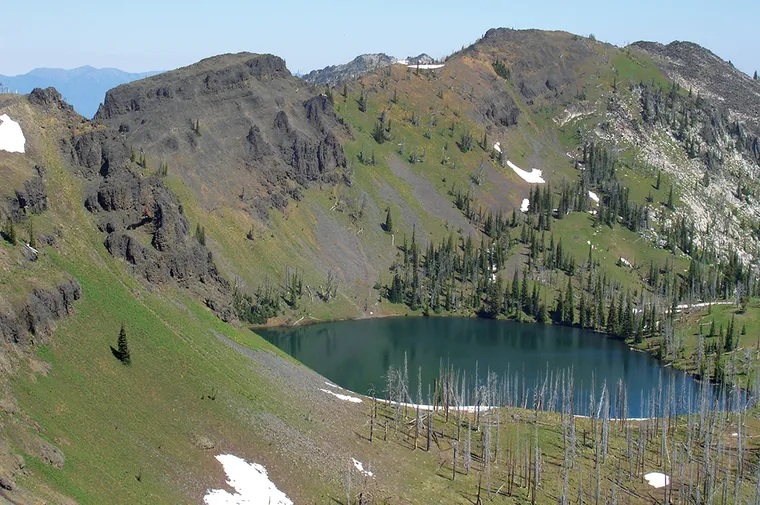Staffing the Payette National Forest’s fire lookouts isn’t for the faint of heart…but oh, what a view
By Melissa Hart
Not much frightens former wildland firefighter Christy Behm. Still, she vividly recalls a night she staffed the Hershey Point fire lookout tower and sat through an electrical storm on a stool with glass insulators on its feet, mapping lightning strikes in the Payette National Forest with her infant son on her lap. “There was a flagpole outside with the American flag, and all of a sudden, the top of the pole started glowing blue,” she says. “I was afraid, but my baby loved to press his face against the window glass and look out at the lightning.”
As a new mother, she needed to earn a salary, but she recoiled from the idea of putting her son in daycare. Instead, she agreed to staff the 10-foot-by-10-foot Hershey Point lookout for a season. “I got paid to be with my son all day, every day,” she says. “I was living in a glass house on top of a mountain. The sunrises and sunsets were just beautiful, and it was very peaceful.”
Behm is one of thousands of fire lookouts across the state who’ve dealt with wild animals and lightning strikes—and in her case, the lack of a refrigerator, running water, and phone/internet service—to protect Idaho’s forests. As a U.S. Forest Service (USFS) employee, she had one main job: every 15 minutes, she had to search for smoke and flame, pinpoint the location, and radio dispatch so that firefighters could quell the blaze before it turned into a full-blown conflagration.
At the start of her season, Behm hiked 1,600 feet up to Hershey Point with her infant on her back. “The supply was a helicopter I used to work on quite a bit when I was a wildland firefighter,” she says. “I knew the pilot well. But Forest Service rules state you can't bring your baby in a helicopter, so I had to hike him up there.” On their commute, she spotted a bear. “I yelled at him to go away, but he wouldn’t. I was nervous, so I pulled out my pistol and shot into the air, and he finally took off. I started thinking to myself, ‘Do I really want to do this?’”
She did, just as passionate firefighters and forest lovers have done throughout 122 years of Idaho’s lookout history.
A Short History Of Idaho Fire-Watching
The first wildfire lookout tower on record is Bertha Hill, 190 miles north of McCall. In 1902, a logging company cook named Mable Gray agreed to the additional duty of climbing a tower—in this case, a 15-foot hemlock snag atop the 5,520-foot summit—twice a day. If she spotted smoke, she leaped onto her pony and raced to find workers who would put out the fire. In 1923, a private timber company built a small, glass-walled building to better serve those who devoted entire summer seasons to watching for fires.
Richard Holm, Jr. is the author of Points of Prominence: Fire Lookouts of the Payette National Forest. He grew up visiting fire lookouts, and he has helped restore several, including a 1914 lookout log cabin on Brundage Mountain. He has visited over 100 lookouts in total. “They’re a unique icon of the West,” Holm says. “The fact that you could live up on a mountaintop for a summer—the whole culture that surrounds fire lookouts—is unique. It defines a lot of who we are as Westerners.”
In the 1930s, the Forest Service hoped to establish a fire watch on every major peak. At one point, Idaho was home to almost 1,000 of the nation’s 8,000 forest fire lookouts. Now, approximately 170 remain in the state—many staffed by USFS employees such as Behm. Idaho lookouts work from June or July until September or October, depending on the severity of fires that season, with two days off each week.

McCall boasts several fire lookouts, some of which are staffed between July and October. “You could, at one time, see a number of fire lookouts from McCall,” Holm says. “You could see the one up at Boulder Mountain, which burned down in the 60s, you could see Brundage and Granite Mountain, which is still active. Council Mountain, which had a lookout on it, and No Business Mountain, which has a lookout.”
The Indian Mountain Lookout on the border of Idaho and Washington has been staffed every season since its construction by the Civilian Conservation Corps (CCC) in 1933, under the direction of Franklin D. Roosevelt, who had 611 Pacific Northwest lookouts built as part of his New Deal. Indian Mountain’s tower has a storage basement and a 14-foot-by-16-foot lookout room with 19 windows, accessible by a bumpy road that Behm navigated during her second season with her now one-year-old in her sturdy old Subaru. This time, she had a working refrigerator and cell phone coverage, along with sweeping views of the forest and Payette Lake.
A lookout’s main instrument is the Osborne Fire Finder, invented by Forest Service employee William Osborne in 1911. It’s a 24-inch diameter instrument that allows the user to look through a brass sight to spot an object such as smoke or flame and find a directional bearing (called an azimuth) on the map below it to pinpoint a potential wildland disaster. “We use measurements including township, sections, and range,” Behm explains. “You want to get on any fires in the early morning, when it's calm and the humidity is high, before the afternoon sun hits it, and it gets hot, and it starts moving quick.”
Judging the distance of a fire, she notes, gets tricky at night. “When we got lightning, I’d get up in the middle of the night and mark the strikes. If I could see a glow, I could shoot an azimuth and pinpoint the fire’s location on a map, and then call dispatch. They’re up all night long. They’d get ahold of the fire managers and start making a plan to suppress it as soon as daylight broke, sending engines or helicopters and smoke jumpers. If I was inaccurate, that could send them on a wild goose chase.”
How To Visit A Fire Lookout
Visitors to McCall can take a chairlift from the Brundage Mountain Resort to the lookout atop the 7,640-foot peak. There’s a viewing platform open to the public, also accessible by car. Holm enjoys visiting No Business Lookout, built by the CCC in 1937. “Harry Shellworth, secretary of the Southern Idaho Timber Protective Association, built the fanciest lookouts in the state,” he says. “There’s a reason I put No Business on the front of my book. It’s a unique building with living quarters on the bottom and an observation room on top. It’s very fancy.”
Behm—now the mother of two teenage sons—hikes up to fire lookouts each summer. “Most of them have nice trails,” she says. “It's fun to visit them.” She especially enjoys the steep two-mile hike up the rocky trail to Granite Mountain Lookout, close to the home she shares with her husband, Forrest, whom she met while they both worked as wildland firefighters.
“Sometimes we'll bring the lookout staff a six-pack of beer if we know them,” she says. “Bringing baked goods is a good idea. Some of them don’t get supplies for a while.”
Holm agrees that if you’re going to visit a fire lookout, it’s polite to bring something from town, such as a newspaper, and to wait to be invited inside. Should you fall in love with the lookout life, know that some are available for rental by visitors eager to spend the night high above the forest in a cozy, glass-walled room with panoramic views.
Holm tells potential visitors to consider a few key aspects of any trip to a fire lookout. “Do you want to drive or hike to the destination?” he says. “What architecture would you like to see?” he adds, noting that the lookouts built in the 1930s by the CCC have a particular charm. “And consider the views you’ll get,” he suggests. “Getting up to a lookout is a great way to see the area where you live. It’s a unique way to learn about your topography.”
For more on fire lookouts:
Books
- Points of Prominence: Fire Lookouts of the Payette National Forest, by Richard H. Holm, Jr.
- The Last Lookout on Dunn Peak: Fire Spotting in Idaho’s St. Joe National Forest, by Nancy Sule Hammond
- Fire Lookouts of the Northwest by Ray Kresek, who also operates a Fire Lookout Museum in Spokane, Washington. Information at www.firelookouts.com
Websites
- “Lookout! Find a New View—McCall Idaho.” www.visitmccall.org
- “10 Amazing Fire Lookouts You Can Rent for the Night.” www.visitidaho.org
Video
- Eyes of the Forest: Idaho’s Fire Lookouts. www.pbs.org



